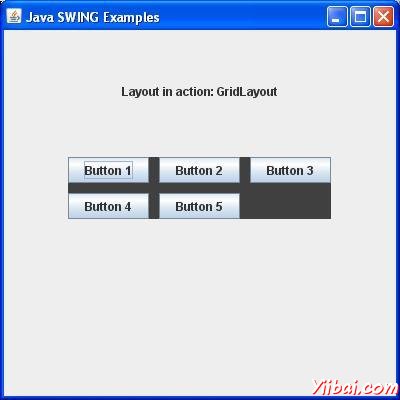Swing GridLayout布局类
GridLayout类将组件排列在一个长方形的网格。
类声明
以下是声明 java.awt.GridLayout类:
public class GridLayout extends Object implements LayoutManager, Serializable
类构造函数
| S.N. | 构造函数 & 描述 |
|---|---|
| 1 |
GridLayout() Creates a grid layout with a default of one column per component, in a single row. |
| 2 |
GridLayout(int rows, int cols) Creates a grid layout with the specified number of rows and columns. |
| 3 |
GridLayout(int rows, int cols, int hgap, int vgap) Creates a grid layout with the specified number of rows and columns. |
类方法
| S.N. | 方法 & 描述 |
|---|---|
| 1 |
void addLayoutComponent(String name, Component comp) Adds the specified component with the specified name to the layout. |
| 2 |
int getColumns() Gets the number of columns in this layout. |
| 3 |
int getHgap() Gets the horizontal gap between components. |
| 4 |
int getRows() Gets the number of rows in this layout. |
| 5 |
int getVgap() Gets the vertical gap between components. |
| 6 |
void layoutContainer(Container parent) Lays out the specified container using this layout. |
| 7 |
Dimension minimumLayoutSize(Container parent) Determines the minimum size of the container argument using this grid layout. |
| 8 |
Dimension preferredLayoutSize(Container parent) Determines the preferred size of the container argument using this grid layout. |
| 9 |
void removeLayoutComponent(Component comp) Removes the specified component from the layout. |
| 10 |
void setColumns(int cols) Sets the number of columns in this layout to the specified value. |
| 11 |
void setHgap(int hgap) Sets the horizontal gap between components to the specified value. |
| 12 |
void setRows(int rows) Sets the number of rows in this layout to the specified value. |
| 13 |
void setVgap(int vgap) Sets the vertical gap between components to the specified value. |
| 14 |
String toString() Returns the string representation of this grid layout's values. |
方法继承
这个类从以下类继承的方法:
-
java.lang.Object
GridLayout Example
选择使用任何编辑器创建以下java程序在 D:/ > SWING > com > yiibai > gui >
SwingLayoutDemo.javapackage com.yiibai.gui; import javax.swing.*; public class SwingLayoutDemo { private JFrame mainFrame; private JLabel headerLabel; private JLabel statusLabel; private JPanel controlPanel; private JLabel msglabel; public SwingLayoutDemo(){ prepareGUI(); } public static void main(String[] args){ SwingLayoutDemo swingLayoutDemo = new SwingLayoutDemo(); swingLayoutDemo.showGridLayoutDemo(); } private void prepareGUI(){ mainFrame = new JFrame("Java SWING Examples"); mainFrame.setSize(400,400); mainFrame.setLayout(new GridLayout(3, 1)); headerLabel = new JLabel("",JLabel.CENTER ); statusLabel = new JLabel("",JLabel.CENTER); statusLabel.setSize(350,100); mainFrame.addWindowListener(new WindowAdapter() { public void windowClosing(WindowEvent windowEvent){ System.exit(0); } }); controlPanel = new JPanel(); controlPanel.setLayout(new FlowLayout()); mainFrame.add(headerLabel); mainFrame.add(controlPanel); mainFrame.add(statusLabel); mainFrame.setVisible(true); } private void showGridLayoutDemo(){ headerLabel.setText("Layout in action: GridLayout"); JPanel panel = new JPanel(); panel.setBackground(Color.darkGray); panel.setSize(300,300); GridLayout layout = new GridLayout(0,3); layout.setHgap(10); layout.setVgap(10); panel.setLayout(layout); panel.add(new JButton("Button 1")); panel.add(new JButton("Button 2")); panel.add(new JButton("Button 3")); panel.add(new JButton("Button 4")); panel.add(new JButton("Button 5")); controlPanel.add(panel); mainFrame.setVisible(true); } }
编译程序,使用命令提示符。到 D:/ > SWING 然后输出以下命令。
D:SWING>javac comyiibaiguiSwingLayoutDemo.java
如果没有错误出现,这意味着编译成功。使用下面的命令来运行程序。
D:SWING>java com.yiibai.gui.SwingLayoutDemo
验证下面的输出


